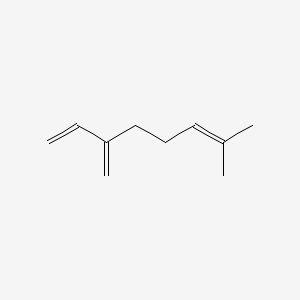| Authors | Title | Published | Journal | PubMed Link |
|---|---|---|---|---|
| Weyerstahl P et al. | Volatile constituents of Plectranthus rugosus leaf oil. | 1983 | Planta Med. | pmid:17404961 |
| Ekundayo O et al. | Volatile Components of Cleistopholis patens. | 1988 | Planta Med. | pmid:17265280 |
| Jayaprakasha GK et al. | Inhibition of prostate cancer (LNCaP) cell proliferation by volatile components from Nagami kumquats. | 2012 | Planta Med. | pmid:22673830 |
| Fäldt J et al. | Functional identification of AtTPS03 as (E)-beta-ocimene synthase: a monoterpene synthase catalyzing jasmonate- and wound-induced volatile formation in Arabidopsis thaliana. | 2003 | Planta | pmid:12624761 |
| Abel C et al. | Floral and insect-induced volatile formation in Arabidopsis lyrata ssp. petraea, a perennial, outcrossing relative of A. thaliana. | 2009 | Planta | pmid:19322583 |
| Arimura G et al. | Herbivore-induced terpenoid emission in Medicago truncatula: concerted action of jasmonate, ethylene and calcium signaling. | 2008 | Planta | pmid:17924138 |
| Lawo NC et al. | The volatile metabolome of grapevine roots: first insights into the metabolic response upon phylloxera attack. | 2011 | Plant Physiol. Biochem. | pmid:21764593 |
| Chen F et al. | Characterization of a root-specific Arabidopsis terpene synthase responsible for the formation of the volatile monoterpene 1,8-cineole. | 2004 | Plant Physiol. | pmid:15299125 |
| Tingey DT et al. | Influence of light and temperature on monoterpene emission rates from slash pine. | 1980 | Plant Physiol. | pmid:16661285 |
| Huang M et al. | Variation of herbivore-induced volatile terpenes among Arabidopsis ecotypes depends on allelic differences and subcellular targeting of two terpene synthases, TPS02 and TPS03. | 2010 | Plant Physiol. | pmid:20463089 |
| van Schie CC et al. | Tomato linalool synthase is induced in trichomes by jasmonic acid. | 2007 | Plant Mol. Biol. | pmid:17440821 |
| Schmidt A et al. | Induction of isoprenyl diphosphate synthases, plant hormones and defense signalling genes correlates with traumatic resin duct formation in Norway spruce (Picea abies). | 2011 | Plant Mol. Biol. | pmid:22002747 |
| Goodger JQ et al. | Isolation of intact sub-dermal secretory cavities from Eucalyptus. | 2010 | Plant Methods | pmid:20807444 |
| Nagegowda DA et al. | Two nearly identical terpene synthases catalyze the formation of nerolidol and linalool in snapdragon flowers. | 2008 | Plant J. | pmid:18363779 |
| Byers KJ et al. | Floral volatile alleles can contribute to pollinator-mediated reproductive isolation in monkeyflowers (Mimulus). | 2014 | Plant J. | pmid:25319242 |
| Dudareva N et al. | (E)-beta-ocimene and myrcene synthase genes of floral scent biosynthesis in snapdragon: function and expression of three terpene synthase genes of a new terpene synthase subfamily. | 2003 | Plant Cell | pmid:12724546 |
| Aharoni A et al. | Gain and loss of fruit flavor compounds produced by wild and cultivated strawberry species. | 2004 | Plant Cell | pmid:15522848 |
| Sylvestre M et al. | Composition and cytotoxic activity of the leaf essential oil of Comptonia peregrina (L.) Coulter. | 2007 | Phytother Res | pmid:17326040 |
| Green S et al. | Unusual features of a recombinant apple alpha-farnesene synthase. | 2007 | Phytochemistry | pmid:17140613 |
| Moradi M et al. | Comparison of headspace solid-phase microextraction, headspace single-drop microextraction and hydrodistillation for chemical screening of volatiles in Myrtus communis L. | 2012 Jul-Aug | Phytochem Anal | pmid:22069217 |
Myrcene
Myrcene is a lipid of Prenol Lipids (PR) class. Myrcene is associated with abnormalities such as Hypomenorrhea, abnormal fragmented structure, Nephrosis, Renal tubular disorder and Kidney Diseases. The involved functions are known as Anabolism, Gene Expression, Protein Biosynthesis, Mutation and Selection, Genetic. Myrcene often locates in Plastids, Proboscis, Body tissue, Clone and soluble. The associated genes with Myrcene are TTPA gene, monoterpene synthase, Genome, 4S-limonene synthase and Homologous Gene. The related lipids are Pinene, Octanols, Membrane Lipids and Fatty Acids, Unsaturated.
Cross Reference
Introduction
To understand associated biological information of Myrcene, we collected biological information of abnormalities, associated pathways, cellular/molecular locations, biological functions, related genes/proteins, lipids and common seen animal/experimental models with organized paragraphs from literatures.
What diseases are associated with Myrcene?
Myrcene is suspected in Nephrosis, Kidney Diseases, Dehydration, Hypomenorrhea, Renal tubular disorder and other diseases in descending order of the highest number of associated sentences.
Related references are mostly published in these journals:
| Disease | Cross reference | Weighted score | Related literature |
|---|
No disease MeSH terms mapped to the current reference collection.
PubChem Associated disorders and diseases
What pathways are associated with Myrcene
There are no associated biomedical information in the current reference collection.
PubChem Biomolecular Interactions and Pathways
Link to PubChem Biomolecular Interactions and PathwaysWhat cellular locations are associated with Myrcene?
Visualization in cellular structure
Associated locations are in red color. Not associated locations are in black.
Related references are published most in these journals:
| Location | Cross reference | Weighted score | Related literatures |
|---|
What functions are associated with Myrcene?
Related references are published most in these journals:
| Function | Cross reference | Weighted score | Related literatures |
|---|
What lipids are associated with Myrcene?
Related references are published most in these journals:
| Lipid concept | Cross reference | Weighted score | Related literatures |
|---|
What genes are associated with Myrcene?
Related references are published most in these journals:
| Gene | Cross reference | Weighted score | Related literatures |
|---|
What common seen animal models are associated with Myrcene?
There are no associated biomedical information in the current reference collection.
